
Building muscle with resistance bands: Are fitness bands just as much of a challenge as dumbbells?
In this article, we take a closer look at the bands and get to the bottom of two important questions: can they really build muscle mass and what advantages do they offer compared to conventional weights?
And then we move from the theoretical to the practical and explore together which resistance band exercises really challenge the core.
Muscle building with resistance bands
Before we talk about the effectiveness of loop bands, let's review the basics of muscle building together. To build muscle mass, you need to provide your muscles with a training programme that combines mechanical tension with metabolic stress. Mechanical tension occurs when your muscles work against resistance, like lifting weights. The higher the resistance, the greater the mechanical tension. For example, if your maximum bench press capacity is 100kg and you do a set of five reps at 80kg, you're facing a lot of resistance, which forces your muscles to adapt.
Metabolic stress, on the other hand, is caused by longer sets with less weight that keep your muscles under tension for a longer period of time. A well-known sign of this is the burning sensation towards the end of a set with many repetitions.
To build muscle, your muscles need to be exposed to both mechanical tension and metabolic stress. This means that sometimes you need to use heavy weights with short sets to promote mechanical tension, while other times you need to use lighter weights with longer sets to increase metabolic stress.
Due to their nature, resistance bands can also generate both mechanical tension and metabolic stress and thus promote muscle growth. We will look at this in more detail in the next section.


According to scientific findings, can you build muscle with resistance bands?
Absolutely possible! A meta-analysis from 2019, which summarised eight different studies, has confirmed this. The results show that training with loop bands enables similar strength gains as training with free weights - in different population groups and using different test methods.
In particular, the studies show that the muscle hardly differentiates between the resistance of free weights and elastic bands as long as the tension remains constant. This is made clear by one of the studies included in the meta-analysis: scientists used electromyography (EMG) to investigate muscle activation during various exercises such as squats, deadlifts and horizontal and vertical pull-ups with resistance bands and free weights. They found that muscle activation was almost identical for every exercise and muscle group!
However, a closer analysis of the study shows that muscle activation was similar - except at the beginning of the movement when the resistance bands were not yet under tension. To optimally promote muscle growth, the muscle should be under tension during the entire movement of the exercise to maximise the crucial time under tension.
Let's take a look at how you can actually optimise your muscle growth with loop bands.
Improve muscle development with resistance bands
To maximise muscle building with resistance bands, make sure you feel the resistance throughout the movement of your exercises to keep the muscle under continuous tension. As mentioned above, muscle activation is similar regardless of whether you are pressing 100kg with a resistance band or free weights. The main difference lies in the resistance: constant with free weights, progressive with fitness bands.
The progressive resistance adapts ideally to the strength curve of the movement. For example, with bicep curls you will feel less resistance at the beginning of the movement and the greatest resistance at the end of the movement. This enables effective loading while at the same time protecting the joints.
A potential problem with progressive resistance is that the muscle may not be under tension for the entire movement. To avoid this, you should stretch the resistance band so that it is already under tension at the start of the movement. For exercises such as the bicep curl, it is better to have a noticeable resistance at the beginning and feel a higher resistance at the end of the movement.
To summarise, it is possible to build muscle with fitness bands, as several studies have shown. However, to really optimise muscle building and achieve similar muscle activation as with free weights, it is crucial to feel the elastic resistance throughout the exercise, which requires correct execution and high-quality equipment.


7 reasons why fitness bands are superior to free weights
Now that we have shown that it is possible to build muscle with resistance bands, let's take a look at the many advantages of training with fitness bands compared to free weights.
1. Strengthening of the joints
- Strengthening the abdominal muscles
- Improving stability
- Promotion of better posture
- Improvement of the movement sequence
The best resistance band exercises for your core
Together we have seen how you can build muscle with loop bands and what advantages they offer compared to free weights. Let's now take a look at which resistance band exercises are particularly suitable for the core and how you can use them for comprehensive strength training. Depending on the strength of the band, you can complete 2-3 sets of 15 to 20 repetitions per exercise, for example. Alternatively, you can perform intensive circuit training: Perform all 5 exercises in succession, load each one for 45 seconds and then take a 15-second break. Repeat this for 2 to 3 rounds.
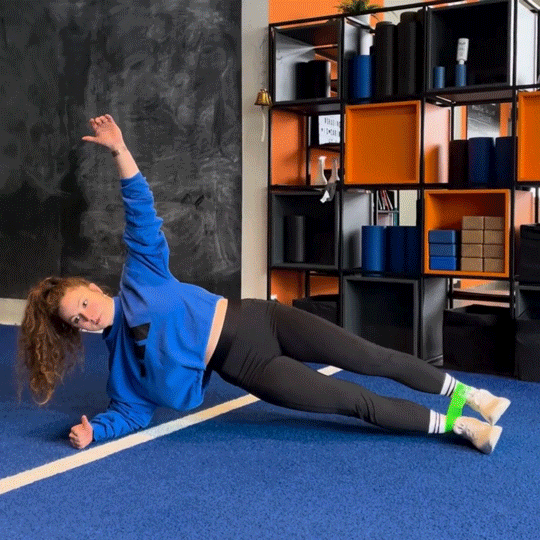
1. Side plank abduction:
The side plank plus leg abduction with the band is an exercise that strengthens the lateral trunk and outer thigh muscles. This is how it is performed:
- Start in the side lying position with your lower arm under your shoulder and your legs stretched out.
- Place the resistance band just above your knees.
- Raise your body into a lateral forearm support position and then lift your upper leg upwards against the resistance of the band.
- Hold the tension for a moment and lower your leg in a controlled manner.
- Repeat on the other side.
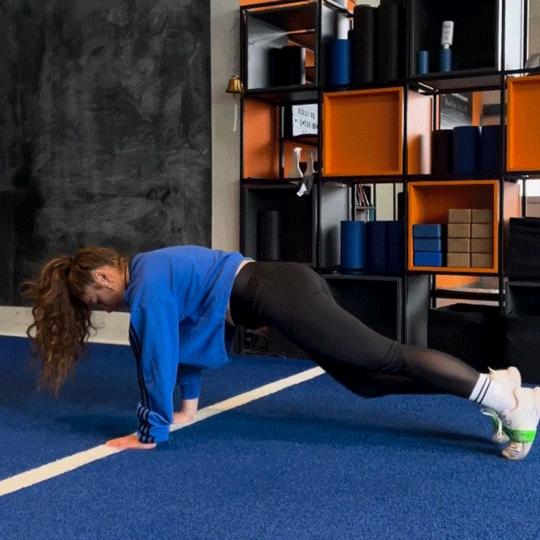
2. Mountain Climbers
This exercise challenges the entire body and particularly trains the abdominal muscles, arm muscles and endurance. Here is how it is performed:
- Start in a push-up position with your hands under your shoulders and your feet hip-width apart.
- Place the mini band around your ankles.
- Alternate between bringing your knees as close to your chest as possible by pulling them quickly towards your chest and then bringing them back to the starting position.
- Make sure that your back remains straight throughout the exercise and that your hips do not sink too high or too low.
- Perform the exercise in a dynamic and controlled manner by alternately moving your knees quickly as if you were running on the spot.
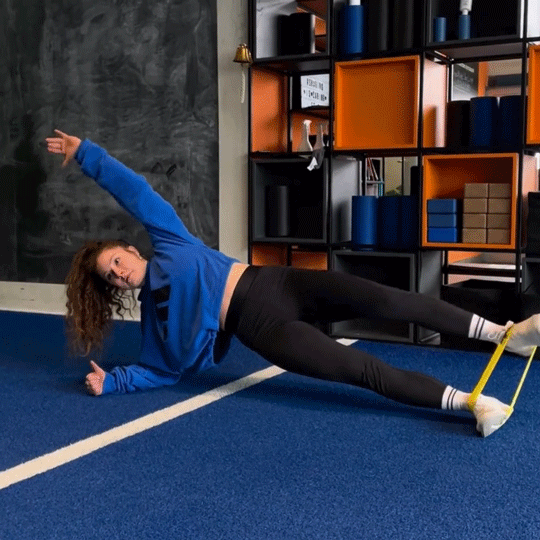
3. Side Plank Crunch:
The side plank crunch with the mini band is an exercise that trains the lateral abdominal muscles and core stability. Here's how to do it:
- Start in a lateral forearm support position with your elbow under your shoulder and your body straight.
- Place the mini band close to your foot.
- Raise your hips to get into a side plank.
- Lower your hips and bring your upper body to your waist using your side abs.
- Return to the starting position and repeat the movement.
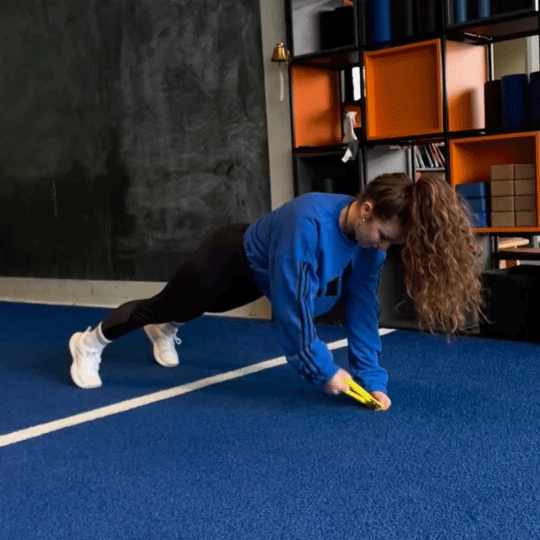
4. High plank rowing with the miniband:
This is an exercise that strengthens the upper back, shoulders and core. This is how it works:
- Start in a high push-up position with your hands directly under your shoulders and your feet up.
- Place the mini band around your wrists.
Alternate pulling one arm upwards by bringing your elbow close to your body and pulling the band upwards against the resistance.
Keep your hips stable and avoid rotating or wiggling them as you perform the exercise.
Lower the pulled arm in a controlled manner and then switch to the other arm.
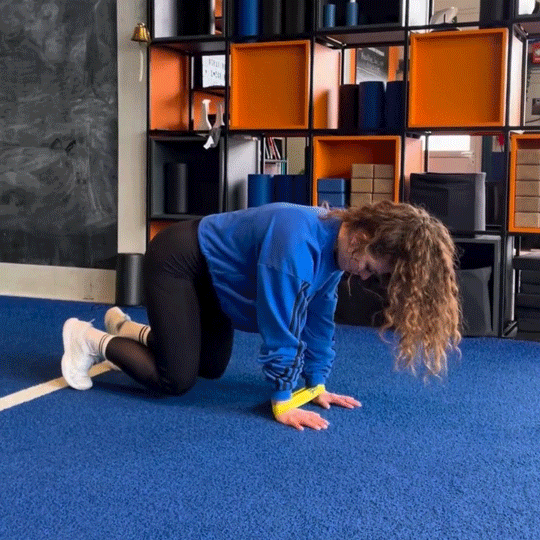
5. Bear with taps:
A full-body exercise that strengthens the shoulders, back, core and hips. This is how it works:
- Start in a quadruped position with your hands under your shoulders and your knees under your hips.
- Place the mini band around your wrists.
- Lift your knees slightly off the floor, keeping your hips stable and your core engaged.
- Alternately tap one hand under your body to the opposite side.
- Keep the movement controlled and repeat with the other hand.








